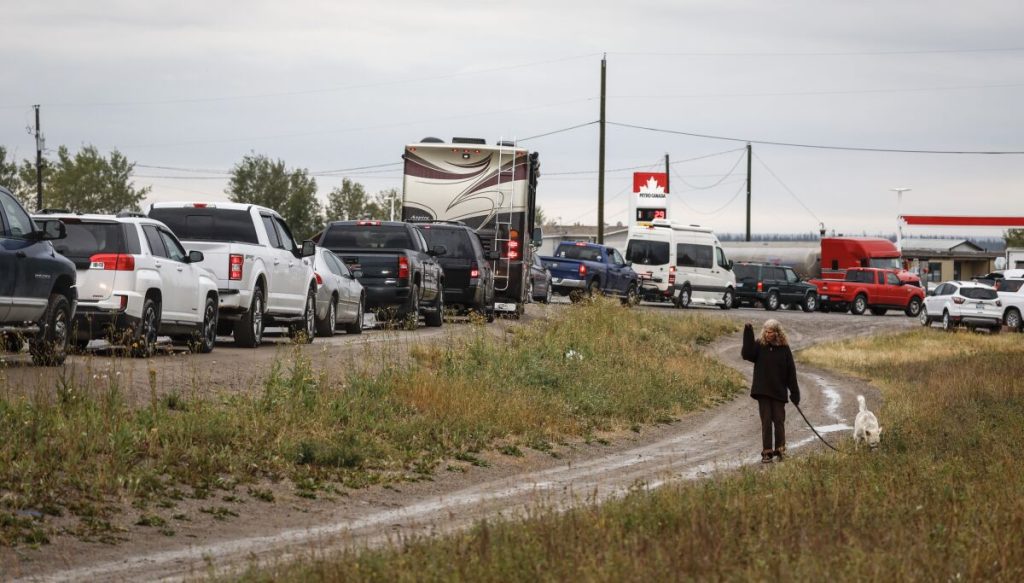Wildfire nears capital of Canada’s Northwest Territories, fleeing residents fill roads

Yellowknife, The Gulf Observer: Residents in the capital of Canada’s Northwest Territories were rushing to beat a noon Friday deadline to evacuate their homes as one of hundreds of wildfires raging in the territories moved closer to the city of 20,000.
Thousands fled on Thursday, driving hundreds of miles to safety or waiting in long lines for emergency flights, as the worst fire season on record in Canada showed no signs of easing.
The fire was within 16 kilometers (10 miles) of Yellowknife’s northern edge Thursday and officials worried that strong northern winds could push the flames toward the only highway leading away from the fire, which was choked with long caravans of cars.
Ten planes left Yellowknife on Thursday with 1,500 passengers, said Jennifer Young, director of corporate affairs for the Northwest Territories’ Department of Municipal and Community Affairs, adding that they hope to have 22 flights leave on Friday with 1,800 more passengers.
“I want to be clear that the city is not in immediate danger and there’s a safe window for residents to leave the city by road and by air,” Shane Thompson, a government minister for the Territories, told a news conference. “Without rain, it is possible (the fire) will reach the city outskirts by the weekend.”
Canada has seen a record number of wildfires this year — contributing to choking smoke in parts of the U.S. — with more than 5,700 fires burning more than 137,000 square kilometers (53,000 square miles) from one end of Canada to the other, according to the Canadian Interagency Forest Fire Centre. As of Thursday evening, 1,046 wildfires were burning across the country, more than half of them out of control.
In the Northwest Territories, 268 wildfires have already burned more than 21,000 square kilometers (8,100 square miles).
The evacuation of Yellowknife was by far the largest this year, said Ken McMullen, president of the Canadian Association of Fire Chiefs and fire chief in Red Deer, Alberta.
“It’s one of those events where you need to get people out sooner rather than later,” because fire could block the only escape route before ever reaching the community.
Yellowknife Mayor Rebecca Alty said Thursday night that the fire isn’t the only concern.
“With the heavy smoke that will be approaching we encourage all residents to evacuate as soon as possible,” she said.
Alty said some good news is the fire didn’t advance as far as originally expected Thursday with crews working hard getting firebreaks in. But “it is still coming,” she said.
Mike Westwick, a fire information officer, said water bombers were being used to fight the flames.
Officials opened a reception center at the Calgary airport in preparation for the arrival of thousands of evacuees. Another center was set up at a hotel for those who drove to the city, said Iain Bushell, the city’s director of emergency management.
Evacuation flights are only for those who cannot leave by road, who are immunocompromised or who have conditions that put them at higher risk, officials said.
“We’re all tired of the word unprecedented, yet there is no other way to describe this situation in the Northwest Territories,” Premier Caroline Cochrane posted on X, formerly known as Twitter.
The evacuation order issued Wednesday night applies to Yellowknife and the neighboring First Nations communities of Ndilo and Dettah.
Indigenous communities have been hit hard by the wildfires, which threaten important cultural activities such as hunting, fishing and gathering native plants.
Amy Cardinal Christianson, an Indigenous fire specialist with Parks Canada, has said the wildfires “are so dangerous and so fast-moving” that evacuations increasingly are necessary, which is a challenge in remote communities where there might be one road in, or no roads at all.
Officials in British Columbia, where about 370 fires are burning, also were bracing for more evacuations, after dry lightning and brisk winds were forecast for the coming days.


